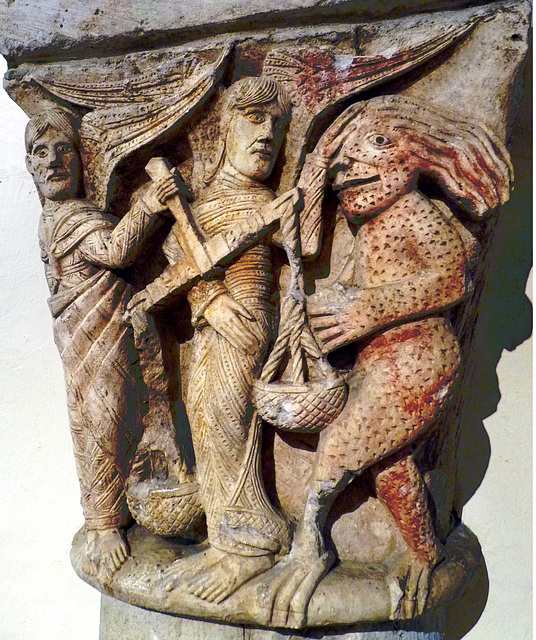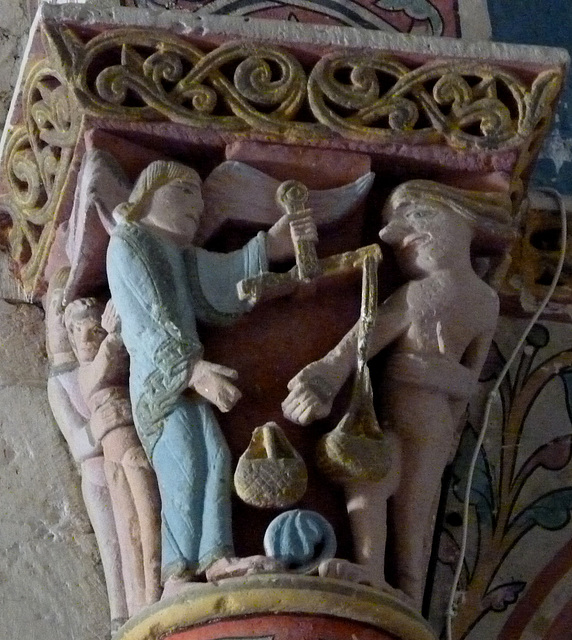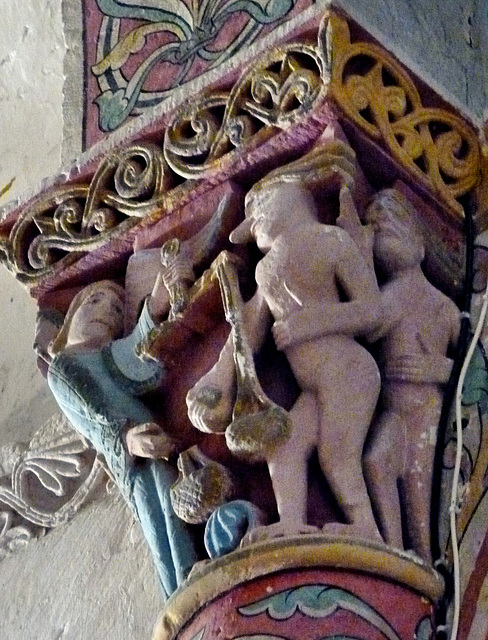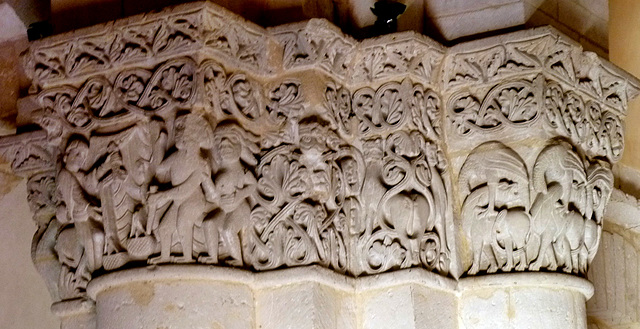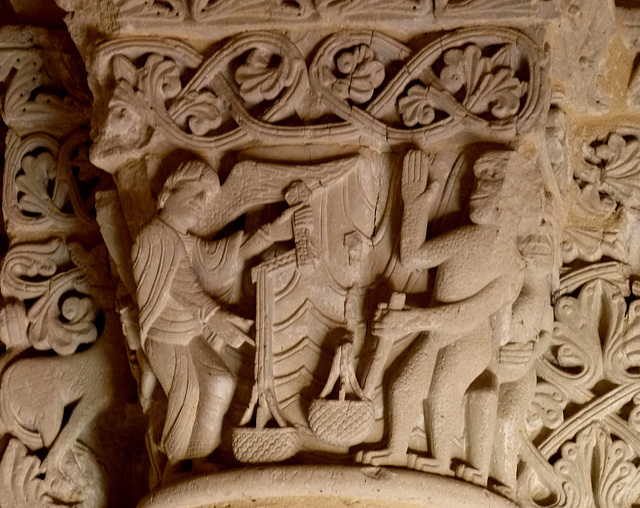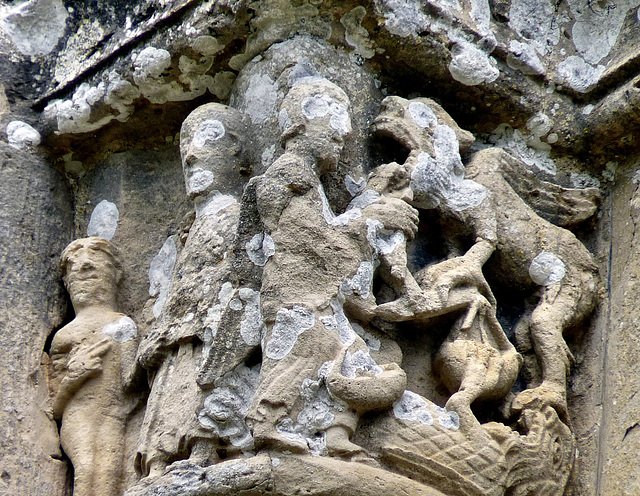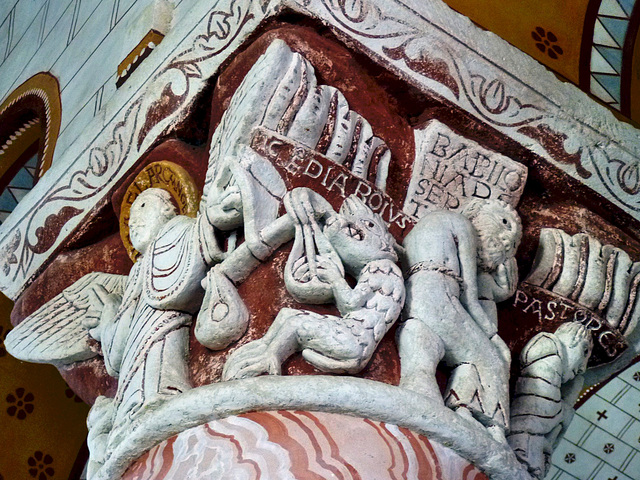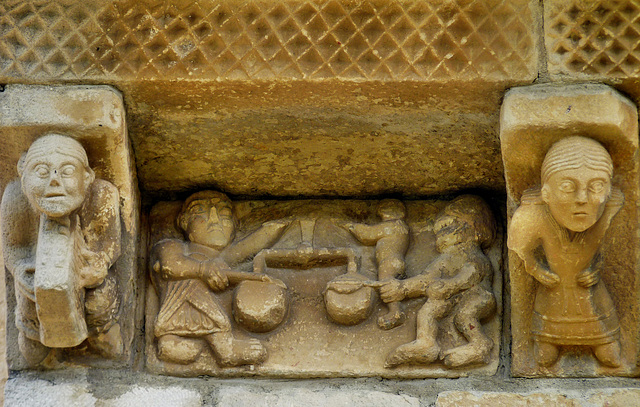
Psychostasia / The Weighing of Souls
A person's life is assessed by weighing the soul in order to judge their fate. A Christian icon connected to the Last Judgement.
Saujon - Saint-Jean-Baptiste
The parish church in Saujon is a sober structure, erected 1679. Since 1912 the nave hosts four Romanesque capitals that once were part of a (lost) church dedicated to Saint Martin.
One of the masterly carved capitals, has this "psychostasia", the Weighing of souls. Depending from the scale - the soul will go either the heaven or hell. Often the scale is held by archangel Michael and often the devil is cheating by holding down the left side of the scale. Here the long-haired devil, who is dotted with pimples, is pushed back be the angel in the center.
Arces - Saint-Martin
An early church has been on this outcrop, overlooking the mouth of the Gironde, since the 11th century. Owned by the abbey of Vaux (today "Vaux-sur-Mer", 24kms north) a new church was erected within the 12th century.
Later the structure, built on a Latin-cross-floorplan, got enlarged and altered a couple of times. The facade seen here dates back to the early 18th century, when a renovation was undertaken thanks to the financial support of Louis XIV.
Despite the many renovation and reconstructions, the Romanesque choir and the crossing, seen here, with the many capitals, were kept intact, as they got integrated into the "new" enlarged church.
One one of the capitals around the choir is this "psychostasia", the Weighing of souls. The style here is much simpler and rougher than at the psychostasia just seen in Saujon (only 18kms northeast). Actually I am sure, that this is a simplified "copy" of the carving in Saujon. In the back of the angel are two saved souls.
Arces - Saint-Martin
An early church has been on this outcrop, overlooking the mouth of the Gironde, since the 11th century. Owned by the abbey of Vaux (today "Vaux-sur-Mer", 24kms north) a new church was erected within the 12th century.
Later the structure, built on a Latin-cross-floorplan, got enlarged and altered a couple of times. The facade seen here dates back to the early 18th century, when a renovation was undertaken thanks to the financial support of Louis XIV.
Despite the many renovation and reconstructions, the Romanesque choir and the crossing, seen here, with the many capitals, were kept intact, as they got integrated into the "new" enlarged church.
One of the capitals around the choir depicts a "psychostasia", the Weighing of souls (see previous upload). The capital now seen from the right side. The devil has already one soul behind him, to accompany him on his way back to hell.
Saintes - Saint-Eutrope
Little is known about St. Eutropius and nothing of this is certain. He may have been native Persian, a companion of the Three Marys, when they went ashore in Saintes-Maries-de-la-Mer, or a native Greek, send to the Saintonge area by Pope Clement I, some centuries later.
After having baptized Eustelle, the daughter of the local governor, he got martyred. Legends tell, that Eustelle got beheaded and so joined St. Eutropius in death.
Gregor of Tour knows about pilgrimages to the tomb of St. Eutropius already within the 6th century.
When later the pilgrimage to Santiago got popular and thousands of pilgrims walked the Via Turonensis each year, this place was a major halt on the "chemin". A larger church was needed. Cluny, a strong "sponsor" of the pilgrimage to Santiago, took over the small community of monks, that existed here since centuries, and sent 20 expert monks. They accepted the challenge.
They started to built the large ambulatory crypt seen here in 1081. The dimensions of the crypt (35 meters long) make clear, what large numbers of pilgrims were expected. The monks did a great job, as already 15 years later Pope Urban II consecrated this crypt.
The basilica-church got completed within the 12th century, but due to the tensions between England and France, Saintes lost its importance for the pilgrims. From 1271 on, the area west of the Charente (incl. St. Eutrope) was English, while the eastern side of Saintes (incl. the Abbaye aux Dames) was French. 1360 Saintes was English, 1404 it was French again.
The church had been altered over the centuries. After the French Revolution a large part of the church got demolished, only the southern wall still is Romanesque. Some decades later, the rebuilding and reconstruction process started. Fortunately many of the marvellous carvings were saved and got reused.
The gate at the the wooden stairs, leading to the gallery, was not locked. Though the stairs seemed pretty fragile for my weight, I climbed up. It was well worth the effort. Nobody was up there, just me and a dead pigeon. Most of the capitals were visible from here.
There are some very elaborate works of art up on the capitals. From right to left:
A fight between lions and birds, an icon often seen all over the Saintonge.
A lion, hidden in the vines, creeping up on a human (hard to see, only the face can be seen at the corner).
A psychostasia, the "Weighing of souls". Within the 12th/13th century Saint-Eutrope was the most important church in the area, so the style seen here and the icons will have been very influential. No wonder that there are three psychostasiae within only 30 kms.
Saintes - Saint-Eutrope
Little is known about St. Eutropius and nothing of this is certain. He may have been native Persian, a companion of the Three Marys, when they went ashore in Saintes-Maries-de-la-Mer, or a native Greek, send to the Saintonge area by Pope Clement I, some centuries later.
After having baptized Eustelle, the daughter of the local governor, he got martyred. Legends tell, that Eustelle got beheaded and so joined St. Eutropius in death.
Gregor of Tour knows about pilgrimages to the tomb of St. Eutropius already within the 6th century.
When later the pilgrimage to Santiago got popular and thousands of pilgrims walked the Via Turonensis each year, this place was a major halt on the "chemin". A larger church was needed. Cluny, a strong "sponsor" of the pilgrimage to Santiago, took over the small community of monks, that existed here since centuries, and sent 20 expert monks. They accepted the challenge.
They started to built the large ambulatory crypt seen here in 1081. The dimensions of the crypt (35 meters long) make clear, what large numbers of pilgrims were expected. The monks did a great job, as already 15 years later Pope Urban II consecrated this crypt.
The basilica-church got completed within the 12th century, but due to the tensions between England and France, Saintes lost its importance for the pilgrims. From 1271 on, the area west of the Charente (incl. St. Eutrope) was English, while the eastern side of Saintes (incl. the Abbaye aux Dames) was French. 1360 Saintes was English, 1404 it was French again.
The church had been altered over the centuries. After the French Revolution a large part of the church got demolished, only the southern wall still is Romanesque. Some decades later, the rebuilding and reconstruction process started. Fortunately many of the marvellous carvings were saved and got reused.
The gate at the the wooden stairs, leading to the gallery, was not locked. Though the stairs seemed pretty fragile for my weight, I climbed up. It was well worth the effort. Nobody was up there, just me and a dead pigeon. Most of the capitals were visible from here.
There are some very elaborate works of art up on the capitals. Here is the psychostasia, the "Weighing of souls", seen on the previous upload, but, now more detailled.
Within the 12th/13th century Saint-Eutrope was the most important church in the area, so the style seen here and the icons will have been very influential. The devil here is dotted with pimples, just like the devil seen on the psychostasia capital in Saujon (30kms west).
Aulnay - Saint-Pierre
"Saint-Pierre d'Aulnay" is a church outside of Aulnay, in the center of an old graveyard. The setting has not changed for centuries. For the pilgrims of the 12th century this church was a major halt - and it still is for all the tourists...
A predecessing church „Saint-Pierre-de-la-Tour“ had been here, that, when the pilgrimage to Santiago de Compostella got more and more popular, was obviously to small, as Aulnay was conveniently situated between Poitiers and Saintes on the Via Turonensis. A new, larger church was needed, so the place was handed over to the chapter of the cathedral in Poitiers. The canons then probably planned this church, that was erected from about 1130/1140 on.
"Saint-Pierre d'Aulnay" is a gem of the "style saintongeais". For Peter Strafford ("Romanesque Churches Of France") this is "one of the best examples of late Romanesque architecture in what used to be Aquitaine".
This is one of the capitals, that are all around the apses. Here is a "psychostasia", the "Weighing of Souls", in a totally different, lively style, than the psychostasiae in Saintes, Saujon and Arces.
Here two very agressive devils (mouths wide open! Scary teeth!) are trying to manipulate the scale (hold by an angel), as depending on the scale the soul will go to heaven or to hell.
Chauvigny - Saint-Pierre
A small community of Canons in Chauvigny was founded by the Seigneurs de Chauvigny around 1025. Bishop Isembert I of Poitiers (+ 1047) was a Seigneur de Chauvigny, as well as his sucessor.
The erection of the Collegiate church started end of the 11th century. It took about a century to complete the structure. The church was in the center of the heavily fortified stronghold, that has a long history of sieges, lootings, captures and recaptures. The "Cité Médiéval" was in ruins end of the 18th century.
Mid 19th century the restauration process started. Since then the interior of Saint-Pierre has this distinctive colour-scheme of white and red. The church is known for the capitals, that are in deed extraordinary.
A psychostasia, the "weighing of souls", to the left. Archangel Gabriel holds the scales. To the right a devil tries to cheat, holding down the
balance beam. HIS E DIABOLUS is written above the devil.
Next to this is a thoughtful prophet labeled BABILONIA DESERT. This probably refers to
Revelation 18 : "Fallen! Fallen is Babylon the Great!"
Actually the prophet looks a bit like the tired, contemplating Joseph, who can often be found near the Nativity scene. And this is near, as to the right is one of the shepherds ("PASTORES"), to whom Gabriel announces Christ's birth (around the corner).
01 Aug 2013
1 favorite
Artaiz - San Martin
This church, dedicated to Saint Martin of Tours, was a real surprise to me. The single nave structure was probably erected within the 12th century. It was built in a "walking distance" off the pilgrim routes (like "San Pedro de Echano"), as the hamlet Artaiz is just about 10kms north of the "Camino Aragonés". San Martin will have been for sure a stopover for pilgrims, who had visited the tomb of Saint Martin of Tours, following the "Via Turonensis".
The masterly composed and carved portal of Saint Martin is extraordinary in the specific iconography, that in parts may reflect the relations to the Islamic neighbours (Reconquista). Here is a script by German arthistorian Hedda Finke about this subject.
art.unt.edu/medieval-symposium/presenter.php?year=2009&am...
Between the seven corbels under the portal´s roof are six large reliefs. This one depicts (probably) the "Weighing of Souls" ("Psychostasia"). A fully dressed angel to the left and a naked devil to the right. The small figure may be the devil´s helper - or the poor soul. The left corbel depicts a musician playing a harp or zither. The person to the right is a dancer.
Sangüesa - Santa María la Real
"Santa María la Real" is one of the highlights for all people following the "Camino Aragonés" - since about 800 years. The facade is impressing it may take hours, to find out the many details. I stayed an extra day, when I had reached the town, just to see the shadows movig over the carvings.
A church did exist here already in 1131 next to the bridge crossing the river Aragon. It was transferred by Alfonso I to the "Knights Hospitaller" (aka "Order of Saint John", later "Sovereign Military Hospitaller Order of Saint John of Jerusalem of Rhodes and of Malta"). The apse is the oldest part of the structure and probably dates back to that time.
The nave and the breathtaking Southern Portal of Santa María la Real were created late 12th/13th century. I uploaded a "total overview" earlier and now will focus more on details.
A detail from the right side of the tympan, depicting the Last Judgement. The right side is actually on God´s left side, standing for the evil. - Here is the Weighing of the Souls (psychostasia). A large snake tries to pull down one side of the scale, held by the archangel. Beside the scale is the mouth of the hell, a nude couple is sinking into it. Below are the heads of the apostles, their fading names are written on the arches.
It seems that the artist knew the much older bas-relief from the portal in Artaiz (ca. 30kms west), as the hellmouth here has the same structure
Jump to top
RSS feed- Latest items - Subscribe to the latest items added to this album
- ipernity © 2007-2024
- Help & Contact
|
Club news
|
About ipernity
|
History |
ipernity Club & Prices |
Guide of good conduct
Donate | Group guidelines | Privacy policy | Terms of use | Statutes | In memoria -
Facebook
Twitter

